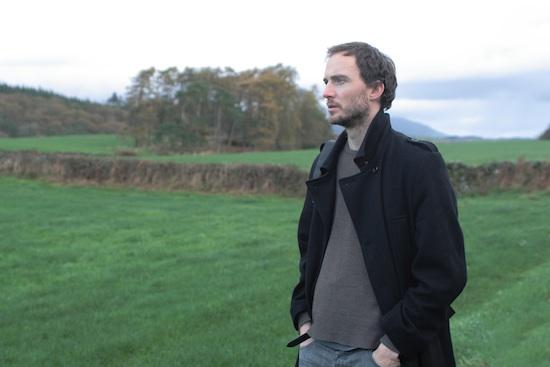After the final notes of his set stop shaking St John On Bethnal Green to its early 19th Century foundations, Richard Skelton stands where the communion rail might normally be, thanks the audience and says, "I think we’re trying to get across the idea that landscape isn’t just pretty green fields and lambs frolicking across it". Tonight’s performance is part of a short tour exploring landscape and Skelton’s words sum it up well – while much music (and indeed writing and art) inspired by landscape can end up as frustratingly anodyne as an amateur watercolour, the three sets in this rather special setting explore the wilds as what they were, are and can be: wild, broken, threatening.
Rob St. John opens with a set of music taken from his excellent forthcoming album Surface Tension. Commissioned by river conservationists Thames21, it sees him creating music and images inspired by and in response to pollution in the River Lea. It felt apt to walk here tonight from the North East of London down the Lea as it makes its way across Tottenham Marshes, where the first buds are appearing on the winter branches. The air is warm with the first hints of a spring evening sun, and acrid smoke from coal burning stoves spirals from the chimneys of moored boats. A man saws logs with a chainsaw, a rat leaps off a pile of dumped rubbish and scurries under a bush, and crusties sit on the deck of their knackered-looking boat, drinking lager. This is not a pretty landscape, and both banks and water are covered in litter that collects on a scummy ooze behind lock gates. Rob St. John’s music at first suggests summer, with bird song and contented flute. The musicians play synths, samples and guitar behind a screen on which are back projected silhouettes of water, exposed film, bubbles and leaves. Yet underpinning – or perhaps undermining – any chance of a bucolic reverie are occasional sections of grinding bass noise, and when Rob St John begins to sing a decidedly mournful song in a deep voice reminiscent of Tindersticks’ Stuart Staples, it’s almost startling.
After this "garden shed Kraftwerk" Laura Cannell’s set played on acoustic instruments is quite the change of atmosphere. Cannell, whose landscape inspiration comes from the Norfolk and Suffolk borders, drags early music into a contemporary sphere, most recently with a remix record featuring the likes of Ekoplekz, Kemper Norton and Hacker Farm. Tonight she uses twin recorders and violin played with the wood of her bow under the body of the instrument, the strings above, creating a scraping drone. Her music is based on fragments of ancient pieces, such as work by 12th century visionary Hildegard Von Bingen and The Cantigas de Santa Maria, a set of medieval poems. ‘Deer Bark’ is, she says, "based on the sound of deers barking in the woods by my house and a piece by Henry VIII", and makes use of her recorder as an instrument to convey the sound of breath as well as melody. Cannell taps into the connection between landscape and the sacred with music that stretches time.
Richard Skelton and Autumn Richardson are dressed for a mildly blustery day on the tops, with sturdy jackets and solid knitwear. Last time I saw him play was an energetic set with the Elysian Quartet at LSO St Luke’s; by contrast tonight’s performance is electronic and the duo sit behind a laptop on a table lit by two candles. In this wonderful setting their music lends itself to contemplation. The material is something of a departure for Skelton, taken from his new album as The Inward Circles, Belated Movements For An Unsanctioned Exhumation August 1st 1984. The record, which take its inspiration from the subterranean, animal bones and the brown and shriveled cadavers of ancient folks preserved in peat bogs, was made using acoustic instruments but then heavily treated with electronics. One of the instruments was a violin that Skelton buried, then exhumed. Tonight, this is what makes music preoccupied with decay in an unforgiving landscape come to vicious life. What I love about Skelton’s work is its savage edge. The worlds he evokes are Romantic in the true sense of the word: haunted, weighed down by sorrow, loss, yearning, the prospect and reality of death. There’s always been an intense contradiction between his beautifully minimalist printed works and the ooze and icy roar of his music, and perhaps by use of electronics this is blurred – supposedly cold technology that one might ordinarily associate with hard lines and the urban becoming ragged heather and fog. Like a landscape or a life, Skelton’s pieces gradually and seamlessly unfold, as if without direction or influence.
The droning motifs are familiar from his older work, but there’s a fizzing static over the top here, pylons marching across a distant moor. Interestingly, this is in a similar sonic area to Tim Hecker or Ben Frost, but where they become stuffy with a pomposity that’s at once macho and drily academic, Richard Skelton’s work cuts to the quick. The sound builds in volume and intensity, until in the final piece a piano disappears under an overwhelming, crushing drone. It pushes the orange lights of London outside the church further and further away from the leaded glass windows, and the air becomes alive with the damp and decay, roots pushing down and through what was once human flesh, and around our bones.


